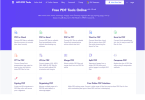AI PDF readers are changing the way people work with digital documents. With an AI PDF reader, users can quickly search, summarize, and ask questions about the content inside any PDF file. This saves time and makes it much easier to find important information without reading every page.
These tools use artificial intelligence to understand documents, spot differences, and even highlight key details. Many AI PDF readers are simple to use—just upload a PDF, type a question or request, and get instant answers. This makes handling large files or complicated contracts far more manageable.
Key Takeaways
- AI PDF readers offer quick and easy ways to work with digital documents.
- Users can search, summarize, and analyze PDFs using simple prompts.
- Advanced features help save time and improve productivity.
Getting Started With AI PDF Readers
AI PDF readers make working with PDF documents faster and easier. A good AI PDF tool can summarize long files, answer questions, and help find key information quickly. Most require only a few simple steps to get started and do not need software installation.
What Is an AI PDF Reader?
An AI PDF reader is a digital tool that uses artificial intelligence to process PDF documents. Unlike traditional PDF readers, these tools can summarize content, extract data, and answer questions about the file. Examples include ChatPDF, PDF.ai, and LightPDF.
Most AI PDF readers allow users to interact directly with their documents, using technologies like OCR (optical character recognition) to process scanned PDFs. This enables features like searching, highlighting, and copying text—even from images. Some platforms also support content translation and insights generation to boost productivity.
One such tool is PDFLyzer, an AI-powered PDF reader built for speed, intelligence, and ease of use. Whether you’re analyzing reports, extracting key data, or working through large, complex files, PDFLyzer simplifies the process—helping you read, understand, and work with PDFs more efficiently.
Some AI PDF readers, such as Foxit or AskYourPDF, focus on quick access and easy sharing. Many tools work in a web browser, so there’s no installation needed. A user just opens the site and starts working with their PDF.
How to Upload Your PDF
Uploading a PDF is often the first step. Most AI PDF readers keep this process simple. On the main page, look for a clear button like Upload PDF or Drag & Drop your file.
Web-based options such as ChatPDF or PDF.ai allow users to upload PDFs from their device or paste a link if the file is online. Some platforms, like LightPDF, let users connect cloud storage such as Google Drive.
After uploading, the document loads for processing. The reader scans the document and prepares it for AI-driven actions. No installation is needed for most popular tools, so all actions happen directly in the web browser.
User-Friendly Interface Features
AI PDF readers offer straightforward interfaces to help users get the most out of their documents. Common features include:
- Text highlighting
- Quick search tools
- Question input boxes
- Sidebar summaries
Some tools, like AskYourPDF and Foxit, provide a chat window for asking questions about the PDF. Others may show a table of contents for faster navigation. These features are designed so that anyone can use the tool without reading a long manual.
Many AI PDF tools also allow exporting answers, copying highlights, or saving notes for reference. These user-friendly features help users review, organize, and share insights from their PDF documents.
Core Functions of AI PDF Readers
AI PDF readers use the latest technology to make working with PDF files easier and faster. They can pull text from scanned pages, summarize long documents, answer questions, and translate content into different languages.
AI-Powered Text Extraction and OCR
AI PDF readers use Optical Character Recognition (OCR) to identify and extract text from scanned documents and images. This means users can copy, edit, or search for information in files that were previously just pictures. For students or professionals, this tool helps save time by turning paper documents into editable digital files.
Even handwritten text in scanned PDFs can sometimes be recognized with advanced OCR features. These tools make it possible to turn old books, receipts, or notes into usable digital text. Text extraction is often as simple as uploading a document and letting the software process it automatically.
Key Features:
- Extract text from images and scanned PDFs
- Convert non-editable documents into searchable files
- Improve accessibility for users with visual needs
Summarizing and Generating Concise Overviews
AI PDF readers can quickly summarize large or complex documents using natural language processing. With just a few clicks, long articles, research papers, or contracts become short, easy-to-read summaries. This makes it much easier to understand the main points without reading the entire file.
AI summarizers highlight important information, topics, or trends in the document. Some tools even let users pick between short bullet-point lists or paragraph overviews. Writers, students, and teams rely on this to review documents faster or prepare for meetings.
Benefits:
- Save time by reading summaries
- Quickly find key information
- Compare several documents side-by-side using concise overviews
Chat With Your PDF and AI Assistants
Modern AI PDF readers include interactive chat features. Users can ask questions about their PDF documents in natural language and get clear, direct answers. For example, by typing “What are the main findings in this report?” the AI assistant will scan the document and reply.
Services like ChatPDF, Acrobat AI Assistant, and pdf.ai let users search content, locate specific details, or clarify confusing passages. This process feels much like chatting with someone who already read the document. AI assistants help with research, work, or any task needing fast access to information without scrolling through every page.
What You Can Do:
- Ask questions about the document’s contents
- Search for names, dates, and topics instantly
- Get explanations or definitions for complex terms
Translation and Multilingual Support
AI PDF readers often come with built-in translation tools. Users can translate all or part of a PDF into another language without needing a separate translation app. This is especially useful for international students, business partners, or teams working with global content.
The translation is powered by advanced AI, making it possible to keep the layout and format of the original document. PDF readers that support multilingual translation can also handle scanned documents using OCR first and then translating the recognized text. This reduces errors and saves time compared to manual translation.
Main Capabilities:
- Translate full PDFs or selected sections
- Maintain document layout after translation
- Support for many world languages
- Combine OCR and translation for scanned PDFs
Advanced Uses and Features
AI PDF readers are equipped with functions that go far beyond basic viewing. These features can assist with detailed analysis, editing, security, and team workflows, making them essential in professional settings.
Searching, Analyzing, and Editing Complex Documents
Modern AI PDF readers can quickly search through large or complex documents to find specific information. Users can ask natural language questions and receive quick answers that are clear and based on the actual content, even if it’s hidden in a table or chart.
With generative AI, the tool can summarize lengthy documents, highlight key points, and extract data from forms or tables. Advanced editing lets users modify text, images, and layout with a few clicks.
These readers often save time when reviewing lengthy legal contracts, scientific papers, or annual business reports. Acrobat Reader AI Assistant and other similar tools frequently support these advanced features for more effective document analysis.
Signing and Secure Processing
AI PDF readers typically offer secure digital signing, making legal agreements and official approvals faster and more reliable. Users can add valid e-signatures with full support for authentication and data privacy.
Many solutions encrypt sensitive documents and restrict access to authorized people only. Secure processing features include automatic redaction of personal data and tracking of all changes for audit purposes. These tools help ensure that documents meet strict legal and business requirements for security.
For businesses handling confidential or regulated information, these capabilities are critical. Automated reminders and verification of signers streamline signature workflows while maintaining compliance.
Collaboration and Brainstorming With Teams
AI-powered PDF readers now support real-time collaboration features. Teams can comment, tag, and suggest edits directly within documents.
Some readers allow users to brainstorm by generating summaries and sharing ideas instantly. Notes, discussion threads, and version history are built in, so everyone stays organized and informed.
Team members can ask questions about the document and get AI-generated answers, helping resolve frequently asked questions without delay. This is especially helpful during meetings or group review sessions.
Legal, Business, and Scientific Applications
In the legal field, AI PDF readers speed up the review of complex contracts by extracting clauses or comparing versions. Automated tracking helps ensure all changes are logged clearly.
For business, these tools can generate reports, extract actionable data, and maintain secure records for compliance. Invoices, statements, and forms are easier to manage and analyze.
Scientific applications include reviewing research papers, extracting citation data, or summarizing findings for reports. AI support makes working with dense, technical documents quicker and less error-prone.
| Use Case | Example Feature |
| Legal | Extract clauses, track changes |
| Business | Generate reports, data extraction |
| Scientific | Summarize papers, citation analysis |







